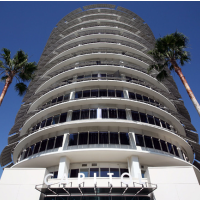Pressured UC Researchers Turn Over Quake Info on Concrete Buildings to L.A.
 Capitol Records building
Capitol Records building
In less time than it takes to clear the rubble from an earthquake-toppled concrete building, University of California researchers have agreed to give Los Angeles data they compiled on 1,500 such structures in the city that theoretically could be at risk.
The researchers have been gathering the data since 2006 as part of a larger project funded by the National Science Foundation (NSF). The Los Angeles Times wanted to take a peek at the numbers and compare them to 1,000 concrete buildings it mapped as part of a series of stories on earthquakes. They were told no.
The researchers said the data was gathered from multiple sources but did not include personal inspections and could not be verified. It didn’t need to for their purposes. Using that information, the project is conducting lab experiments and computer simulations to understand, predict and mitigate how concrete structures perform in an earthquake.
Fearing legal liability, the researchers indicated they would turn the information over to the city—if it asked—once the project was complete.
The city asked and, last week, completed negotiations to receive the data.
Although preliminary studies indicate that a big quake would only take down about 50 of the 1,000 buildings earmarked by the Times, they include iconic structures like Capitol Records. It would make quite a mess and kill a lot of people.
That’s why experts were warning after the devastating 1971 Sylmar earthquake that concrete buildings had to be surveyed and reinforced or torn down. The warning was reinforced after the 1994 Northridge quake, but very few of the buildings were.
Once the city has the information, it will have to decide what to do with it. Doing a proper survey of the city’s concrete properties, evaluating them for safety, setting up a process for addressing the problem and then actually fixing the buildings would be enormously expensive and fraught with the usual bureaucratic frustrations that accompany such endeavors.
The questions of who has to make mandatory repairs and who picks up the cost would reverberate through the city’s political structure. There are reasons this critical work hasn’t been done over the past 40 years and it remains to be seen if much has changed.
–Ken Broder
To Learn More:
In Reversal, Quake Researchers to Turn over List of Concrete Buildings (by Rong-Gong Lin II, Rosanna Xia and Doug Smith, Los Angeles Times)
Los Angeles, UC Researchers Squabble over Quake Info on More than 1,000 Vulnerable Buildings (by Ken Broder, AllGov California)
Los Angeles Inventory of Nonductile Concrete Buildings for Analysis of Seismic Collapse Risk Hazards (University of California) (pdf)
- Top Stories
- Controversies
- Where is the Money Going?
- California and the Nation
- Appointments and Resignations
- Unusual News
- Latest News
- California Forbids U.S. Immigration Agents from Pretending to be Police
- California Lawmakers Urged to Strip “Self-Dealing” Tax Board of Its Duties
- Big Oil’s Grip on California
- Santa Cruz Police See Homeland Security Betrayal in Use of Gang Roundup as Cover for Immigration Raid
- Oil Companies Face Deadline to Stop Polluting California Groundwater





